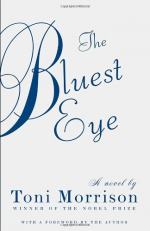|
This section contains 3,551 words (approx. 12 pages at 300 words per page) |

|
SOURCE: Kulkarni, Harihar. “Mirrors, Reflections, and Images: Malady of Generational Relationship and Girlhood in Toni Morrison's The Bluest Eye.” Indian Journal of American Studies 23, no. 2 (summer 1993): 1-6.
In the following essay, Kulkarni interprets Pecola's fate in The Bluest Eye through Jacques Lacan's theory of the mirror stage of psychosexual development, tracing the origin of Pecola's sense of inferiority to Pauline's self-image.
The Bluest Eye is Toni Morrison's The Waste Land. Like Eliot, she too, in a limited sense, presents bleak, wastelandish human conditions characterized by grotesque environment which, like the earth of 1941, is unyielding. She brings into focus a place that fosters an underground invisibility and barrenness, composed of an imaginary cultural dissolution and fraught with brutal discrimination that strains human comprehension and stuns our conscience; where the “soil is bad for certain kinds of flowers. Certain seeds it will not nurture, certain fruit it will not bear...
|
This section contains 3,551 words (approx. 12 pages at 300 words per page) |

|


